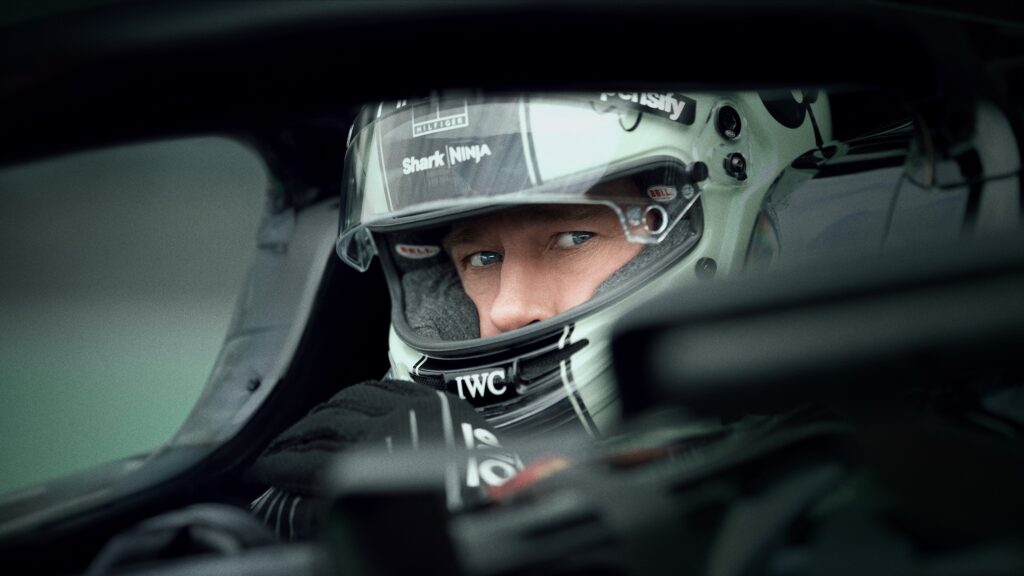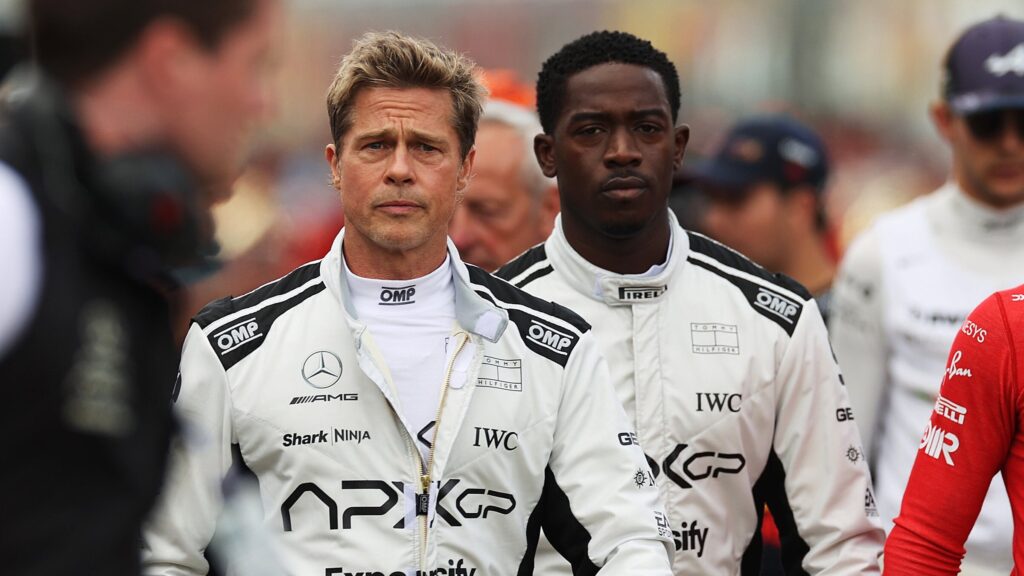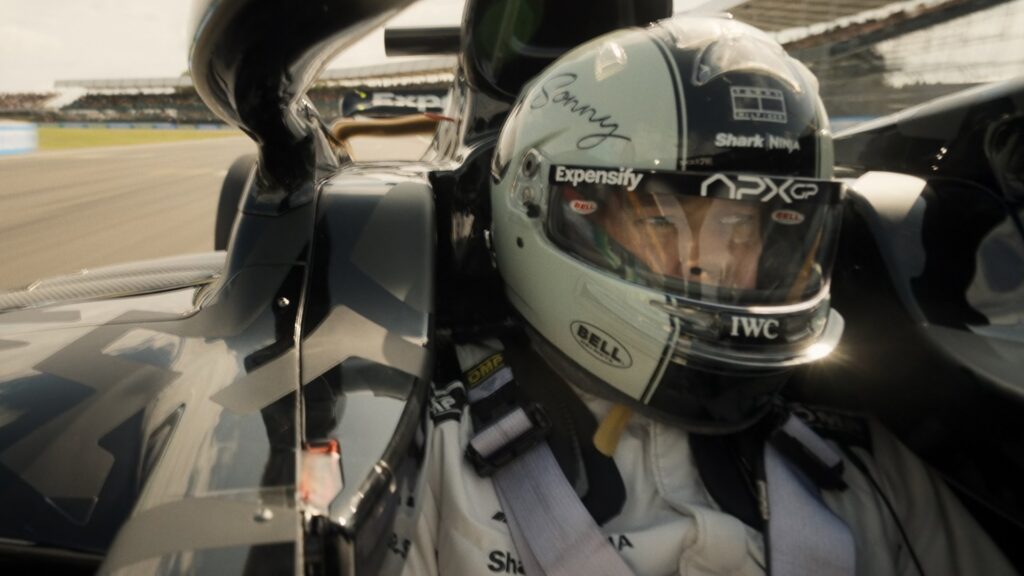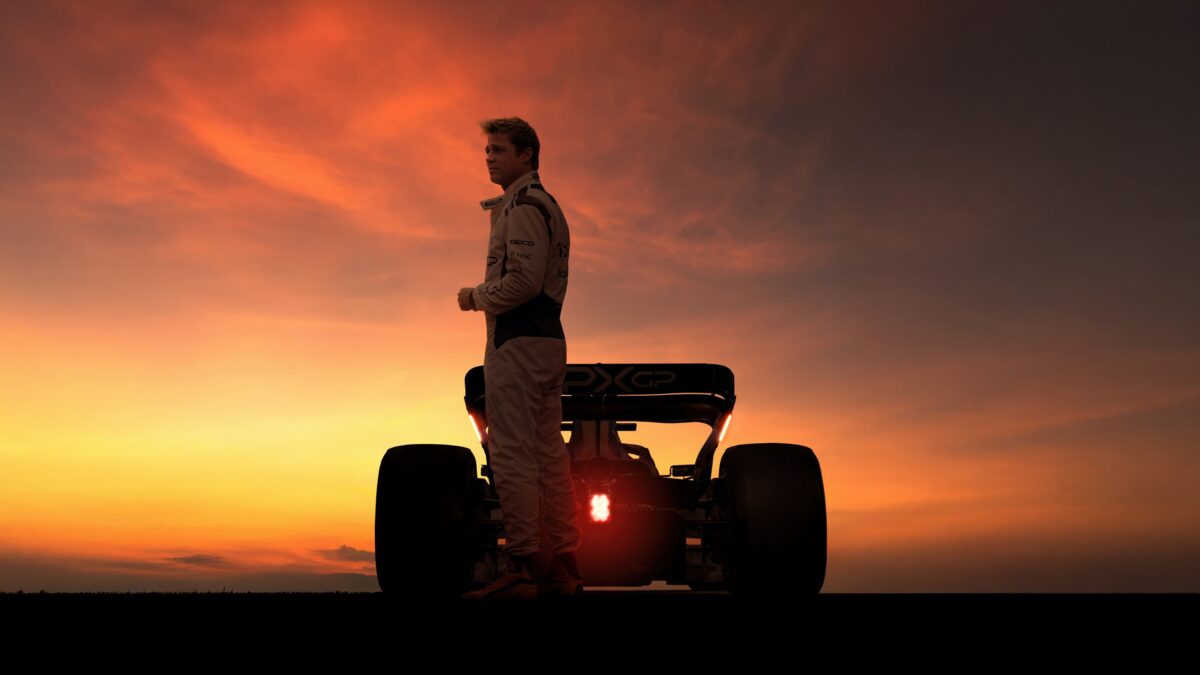Executing the formula
I will indulge the metaphor that repeatedly clanked around my head as I watched F1: this film is like the car its hero drives: an industrial machine; engineered down to the micrometer; expensive; polished; propulsively powerful; and very, very good at completing exactly its job. (Surpassing almost two and a half hours, I wouldn’t exactly call it a “fast” movie, so I guess my metaphor falls apart pretty quickly.) This is not “high art”; but movies that aim to be entertainment at this scope and level of professionalism are rarer than the ambitious festival fare these days, which perversely makes F1 feel more special than, I dunno, The Brutalist.
F1 is such a natural extension of and companion piece to the similarly outstanding Top Gun: Maverick that everyone has rushed to call it “Kosinski’s follow-up to Maverick,” except… that’s not true. Not a single review site I frequent or Letterboxd pal of mine has brought up the fact that Joseph Kosinski made a movie in between, the panned and instantly forgotten Spiderhead starring Chris Hemsworth, which I still haven’t seen (and I’m guessing most of those folks haven’t either). Everyone would rather diagram the parallels and gear shifts between F1 and Maverick than connect F1 to Spiderhead. But fair enough: Maverick made $1.5 billion and was a rare all-crowds pleaser; Spiderhead wasn’t even the most popular Netflix original the summer it came out.
More to the point, F1 marks the second pairing between Kosinski and producer Jerry Bruckheimer, a titan of satisfying blockbuster spectacle. Tying even more strings in this web, two of Bruckheimer’s earlier crown jewels are Tony Scott’s Top Gun and the racing picture he made a few years later, Days of Thunder, which each shoots further up my “how the hell have I still not watched this?” list given my love of Top Gun. For the record, I’m one of those rare birds who thinks the original Top Gun is the better movie (by tiny fractions) and the more interesting one (by very large fractions) than its legacy sequel Maverick.

The “it’s like Maverick, but about racing” narrative around F1, while accurate, is a bit like rehydrating the raisin: Maverick already had sports-movie DNA baked in (but then, sports movies have a hefty amount of war cinema in their genetics, so good luck unwinding that ouroboros). What F1 clarifies is how perfectly the simple, durable machinery of a sports story fits Joseph Kosinski in this filmmaking mode. The sport in question is powered by fast, noisy machines that make your bones rattle, much like Maverick’s military discipline is powered by fast, noisy machines that make your bones rattle. Thus, Kosinski he can reuse and refine the same visual grammar: cockpit POVs that throw you in the action, cross-cutting that ratchets tension and energy, and spatial geography so clean you could diagram it with graph paper.
F1’s story is what I call the Bull Durham stock plot: a cynical, washed-up star butting heads with the talented greenhorn until their grudging synthesis unlocks victory and actualization. (Other movies got there first, I’m sure, but none that I’m familiar with did it better than Bull Durham, so it gets ownership of the formula.) Christopher McQuarrie is out, and while some Mission: Impossible snap would have been welcome, Ehren Kruger carries over from Maverick and brings a similar knack for sturdy writing built around set pieces. Kosinski also gets story credit this time.
The washed-up old head, in F1’s case, is Sonny Hayes (Brad Pitt), who is a halfway point between Pitt’s executive in Moneyball and his breezy thief in Ocean’s Eleven. If that character hybrid doesn’t entirely make sense, that’s fine, because the part ultimately asks for “Brad Pitt, the effortlessly cool leading man,” and he delivers exactly that in the right register. (He’s not quite as locked in as he was in Babylon, but still good.) One upside of having Pitt in the lead is that he is unafraid of being humbled and kicked around by his story. He doesn’t sand down the creaks in the joints or the over-nurse ego scabs. You buy that he’s a little bit washed. This makes his eventual competence feel earned rather than ordained. This is in contrast to Maverick’s biggest problem, which is that it has to split the difference between “Tom Cruise is aging” and “Tom Cruise is ageless,” building its story to elevate the mythos of Cruise as the last real movie star as much as any of its other stakes. No such secondary objectives in F1.

F1’s other key figures include the rookie Sonny feuds with but ultimately mentors, Joshua Pearce (Damson Idris). He’s a wunderkind with everything a great racer needs except the pesky “winning races” requirement, a perfect sponge for Sonny’s wisdom once he drops the ego. The team boss is Ruben Cervantes (Javier Bardem), an old chum who yanks Sonny out of his stateside detours in desperation. The last key figure is Kate McKenna (Kerry Condon), APXGP’s technical chief and the de facto romantic interest. Despite my Bull Durham comparison, this never threatens to become a triangle; everyone clocks the Pitt–Condon chemistry from “go,” and the movie even lampshades this: Bardem barely blinks when he finds Sonny half-clothed in Kate’s hotel room.
If you’ll permit one more clunky metaphor: the engine of this film, the thing keeping it always moving forward and clicks every gear in sync, is the racing itself. It’s terrific, and crucially, it has decent variety. You feel the roaring heft of the acceleration and the jitter of every twitch of the steering wheel. Because so much of the footage is practical rather than CG, with Pitt and Idris actually flinging themselves around in tin cans moving 150+ mph in real life, the footage carries a lived-in menace that computers can’t fake. Kosinski keeps changing the framing and the rhythm just enough so it never gets boring or blurs into sameness, despite the fact that professional racing boils down to “turn left a bunch of times.”
The story fills the spaces between those set pieces like tendon and muscle between bones, but the real narrative shape occurs within the races: the micro-dramas of passes, safety cars, and pit stops. You observe the characters develop lap by lap. That part works gangbusters… up to the movie’s favorite punchline: the crash. It’s undeniably cinematic: failure made fireball. But after the fourth or fifth crash, it loses its sense of danger. Whenever a race starts, you might wonder: Will this one end in a near-fatal crash? Spoiler: The answer is almost definitely “yes.” This pattern undermines the supposedly dramatic revelation that Sonny’s body has become chronically damaged from repeated crash injuries. Wow, getting in high-speed accidents over and over isn’t considered good self-care?

F1, as a cinematic package, is assembled with the utmost industrial love. The returning Maverick brain trust clicks back into place: Hans Zimmer (with Steve Mazzaro co-credited) delivers a sensational score that’s a blend of retro and modern, electronic-tinged but soaring, as if it was written for a vintage Tony Scott movie but with Dolby Atmos in mind. Claudio Miranda’s cinematography is a bit of a throwback, too, evoking some ‘80s texture that’s not so glossy or gray-brown as you’d expect from a 2020s tentpole. And Stephen Mirrione, Steven Soderbergh’s preferred hand and one of the few cuts 155 minutes like he’s managing tire degradation: lift-and-coast where it counts, then attack the apex when the film needs a jolt. For a movie this long and this shiny, the pulse is surprisingly steady.
One recurring criticism of F1 among the mixed or negative takes is that the movie is just a big ad for Formula One racing. It’s true the movie is stuffed with racer cameos and corporate logos, and it carries a constant air of calculated, risk-free fun. And this take isn’t exactly wrong, but it’s merely a byproduct of F1 doing its job really damn well. Top Gun: Maverick made the Navy look like a recruitment pitch and still played like gangbusters; F1 makes racing look cool because driving really fast is cool. The F1 branding is a natural part of the racing world rather than shameless product placement.
Since half this review is “kinda like Maverick, but…,” here’s the part where I answer the question I didn’t expect I would even need to ask. Is F1 better than Top Gun: Maverick? Could this film actually be a more satisfying watch than the film that is a strong contender for the decade’s most revered blockbuster? It’s close. Maverick was one of my favorites of 2022; I expect F1 to race near the front of the pack when 2025 wraps, too. But I still give a tiny edge to Maverick, which lands a few more emotional body blows — the Val Kilmer scene has no match here, and I cared more about mustachioed Miles Teller and Glen Powell than I ever did Damson Idris. That said, the mere possibility of a photo finish is proof that F1 is a resounding success and a contender for my favorite big-budget movie of the year.
Is It Good?
Very Good (6/8)
Dan is the founder and head critic of The Goods. Follow Dan on Letterboxd. Join the Discord for updates and discussion.


One reply on “F1 (2025)”
I was aware Spiderhead though I thought it came out before Maverick; in fairness, I was *almost* right. It was only a month later! Something to watch at some point, I guess, though the key question is “is this more like Only the Brave or Oblivion?”
I mean, you know this, but count me as a huge booster of the proposition, “F1 is better than Maverick.” Still, yeah! Glad you dug it.